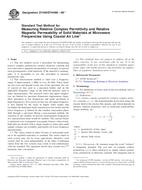Potrebujeme váš súhlas na využitie jednotlivých dát, aby sa vám okrem iného mohli ukazovať informácie týkajúce sa vašich záujmov. Súhlas udelíte kliknutím na tlačidlo „OK“.
ASTM D7449/D7449M-08e1
Standard Test Method for Measuring Relative Complex Permittivity and Relative Magnetic Permeability of Solid Materials at Microwave Frequencies Using Coaxial Air Line (Includes all amendments And changes 12/12/2014).
Automaticky preložený názov:
Štandardná skúšobná metóda pre meranie relatívnej komplexné permitivity a relatívnu magnetickú permeabilitu pevných látok u frekvenciou mikrovlnnej rúry pomocou koaxiálneho Air Line
NORMA vydaná dňa 15.11.2008
Informácie o norme:
Označenie normy: ASTM D7449/D7449M-08e1
Poznámka: NEPLATNÁ
Dátum vydania normy: 15.11.2008
Kód tovaru: NS-38478
Počet strán: 8
Približná hmotnosť: 24 g (0.05 libier)
Krajina: Americká technická norma
Kategória: Technické normy ASTM
Anotácia textu normy ASTM D7449/D7449M-08e1 :
Keywords:
coaxial line, dielectric constant, loss factor, magnetic permeability, measurement, microwave, millimetrewave, permittivity, radio frequency, scattering parameter, transmission/reflection, Coaxial line, Magnetic permeability, Microwave frequencies, Relative complex permittivity, ICS Number Code 17.220.20 (Measurement of electrical and magnetic quantities)
Doplňujúce informácie
| Significance and Use | ||
|
Design calculations for radio frequency (RF), microwave and millimetre-wave components require the knowledge of values of complex permittivity and permeability at operating frequencies. This test method is useful for evaluating small experimental batch or continuous production materials used in electromagnetic applications. Use this method to determine complex permittivity only (in non-magnetic materials) or both complex permittivity and permeability simultaneously. |
||
| 1. Scope | ||
|
1.1 This test method covers a procedure for determining relative complex permittivity (relative dielectric constant and loss) and relative magnetic permeability of isotropic, reciprocal (non-gyromagnetic) solid materials. If the material is nonmagnetic, it is acceptable to use this procedure to measure permittivity only. 1.2 This measurement method is valid over a frequency range of approximately 1 MHz to over 20 GHz. These limits are not exact and depend on the size of the specimen, the size of coaxial air line used as a specimen holder, and on the applicable frequency range of the network analyzer used to make measurements. The practical lower and upper frequencies are limited by specimen dimension requirements (large, thick specimens at low frequencies and small specimens at high frequencies). For a given air line size, the upper frequency is also limited by the onset of higher order modes that invalidate the dominant-mode transmission line model and the lower frequency is limited by the smallest measurable phase shift through a specimen. Being a non-resonant method, the selection of any number of discrete measurement frequencies in a measurement band would be suitable. The coaxial fixture is preferred over rectangular waveguide fixtures when broadband data are desired with a single sample or when only small sample volumes are available, particularly for lower frequency measurements 1.3 The values stated in either SI units or inch-pound units are to be regarded separately as standard. The values stated in each system may not be exact equivalents; therefore, each system shall be used independently of the other. Combining values from the two systems may result in non-conformance with the standard. The equations shown here assume an e+jωt harmonic time convention. 1.4 This standard does not purport to address all of the safety concerns, if any, associated with its use. It is the responsibility of the user of this standard to establish appropriate safety and health practices and determine the applicability of regulatory limitations prior to use. |
||
| 2. Referenced Documents | ||
|
Odporúčame:
Aktualizácia technických noriem
Chcete mať istotu, že používate len platné technické normy?
Ponúkame Vám riešenie, ktoré Vám zaistí mesačný prehľad o aktuálnosti noriem, ktoré používate.
Chcete vedieť viac informácií ? Pozrite sa na túto stránku.




 Cookies
Cookies
